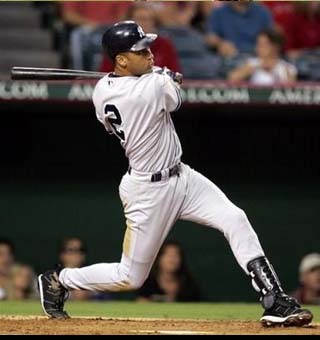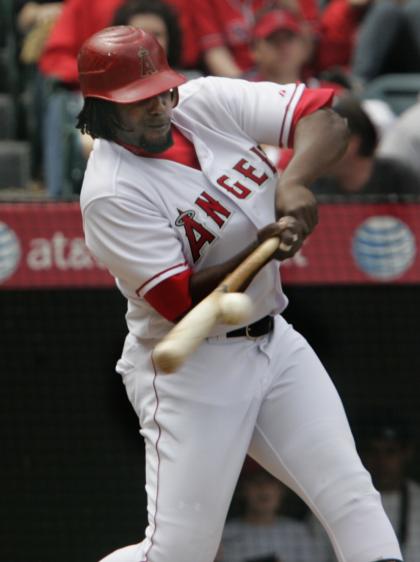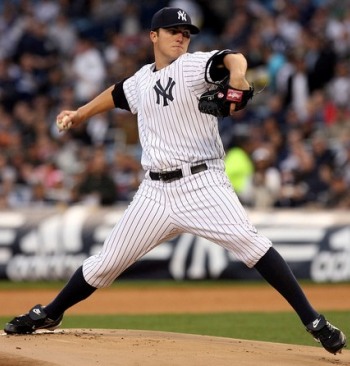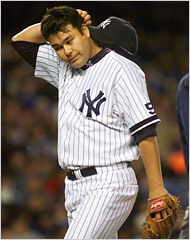Let's get this out of the way right now: Bengie Molina is not a bad baseball player.
Granted, he's not great. But he is good.
The news out of Bay City this morning is that erstwhile Giants' catcher Bengie Molina will also be the future Giants' catcher, at least for 2010. Having spurned a similar offer from the Mets, where a lot of people expected him to wind up, he's returning to the safety (and relative non-dysfunctionality) of San Francisco. ESPN is reporting that he's signed a one-year deal for $4.5 million, and apparently no buy-out or vesting options (as the Mets had offered), though there are incentives for up to another million and a half dollars based on playing time.
The Giants had reportedly lost out on the chance to re-sign Molina, as GM Brian Sabean said after the winter meetings in December, but this sudden news obviously negates all of that. Perhaps Molina saw the difficulty the Mets are having replacing their departed free agents, or started thinking more seriously about all the bizarre stuff that seems to happen there. Perhaps he remembered his career .130 batting average at Shea Stadium, and forgot that they don't play there anymore. Perhaps he feared living up to the high standard for Molina catchers in New York put up there by his kid brother...no matter. That's all ancient history now.
The thing I don't get is why Giants' fans are so upset about this. McCovey Chronicles has a fairly hilarious take on it (H/T to Rob Neyer), and Brian Sabean has done some pretty dumb things in his tenure as General Manager there, but I'm not sure this is one of them. The argument against the signing is that Molina's not a very good hitter and he's a terrible baserunner (so much so that commenters on a Joe Posnanski blog post once suggested that slowness could be measured in "Molinas"). But the reality is that Molina's not so terrible, and neither is the deal. In any case, somebody has to catch the ball, right?
The supposed plan was to use rookie Buster Posey as the Giants' starting catcher, but Sabean had second thoughts, or at least managed to convince Molina that there was nothing better out there (i.e. a multi-year deal). I suppose the fans are upset because they were looking forward to their wunderkind backstop, much as another team's fans, also wearing orange and black but 3,000 miles away, were looking forward to Matt Wieters at this time last year.
For his part, Wieters struggled in his first few months in the majors, hitting just .259/.316/.407 before the All-Star Break,before finding his stroke in the second half (.301/.351/.415). Overall, he was just an average major league hitter, which is pretty good for any rookie, much less a catcher. But he was far from the second coming of Mike Piazza that the pundits expected.
And Posey's projections for 2010 aren't even as good as Wieters' were for 2009. FanGraphs suggests that Posey could put up an OPS in the neighborhood of about .740 next season, though it's worth noting that he's got only about 40 games of experience above high-A ball. Compared to Molina's projection of about a .720 OPS, based on more than a decade of MLB service, the difference is all but negligible.
Granted, at just 22 years old, Posey's got a lot more upside, and the additional $4 million they'll have to pay Molina isn't negligible, but for a major league team, it's close enough. If Molina's suddenly a live option, at least for 2010, better to put off Posey's promotion for all or part of a year and give him a good chance to adjust to the majors than to rush him in and risk ruining one of the game's best prospects.
And this is where my initial statement, about Molina not being such a bad player, comes in. According to FanGraphs, Bengie was worth $8.1 million in 2009...and made "only" $6.5 million. This year they expect him to be worth between six and seven million dollars, depending on whose projections you want to believe, and he will again make about a million dollars less than that. This, my friends, is the very definition of a bargain.
Is he the best catcher in the majors? No, not by a long shot.
But was he the best catcher available? Yes. By an even longer shot.
He's as slow as pond water on the bases, on the rare opportunities he has to "run" them, because he only takes an unintentional walk about once every three weeks. But he does hit for a modest batting average and has enough pop in his bat to keep pitchers somewhat honest. He seems to call a good game, though his ability to catch would-be base stealers is less than stellar. Still, with a staff that doesn't allow a lot of baserunners and strikes a lot of men out, this is not such a big deal.
Take a look at the alternatives:
Brad Ausmus, Age 40
Positive: Posted his first OPS above .700 for a season since Y2K!
Negative: Needed a week off between starts to do it.
Ausmus has been the archetype for the good-field, no-hit catcher for more than a decade, surviving on his supposedly legendary pitch calling ability, his tenacity as a competitor and his "brains" (which Ausmus himself admits is a nice way of saying that he can't hit) for far longer than anyone would have guessed. He gives hope to all the Dusty Ryans and Francisco Cervellis of the world.
But he's old. He can't hit. He can't catch often anymore. He's not an option for the Giants.
Paul Bako, age 37
In his first two seasons in the majors, he was a semi-regular and posted a combined .690 OPS in 580 plate appearances, a useful amount of production out of a backup catcher. But in the 10 years and more than 600 games he's played since, he's hit .220/.299/.307. The only other players who have appeared in at least 600 games in that span without hitting better are John McDonald, a defensive wiz who plays three infield positions, and seven relief pitchers.
Jose Molina, age 34
A year younger than his brother, but can't hit even more (less?) than Ausmus can't, and never could. He parlayed a couple of months of hitting a little bit while backing up Jorge Posada into an extra two years with the Yankees, and has a World Series ring for his efforts, but doesn't have a clue with the bat or any business starting regularly for a major league team.
Yorvit Torrealba, age 31
Not so old, and seemingly better with the bat than some of the other options, except that his home road splits during his time in Colorado suggest that he's really just as bad, if not worse. His road OPS from 2006-2009 is about .650, which would make him one of the half dozen or so worst hitters in the majors if he got enough playing time.
Rumors are now that the Mets may sign him. That makes sense.
Shawn Riggans, age 29
The youngest of the group, and he's not all that young. He's hit around the Mendoza Line in parts of four seasons with the Rays, and his minor league numbers are unimpressive.
Rod Barajas, age 34
Barajas is Bengie Molina without the "batting average". He's almost the same age, hits a few homers, doesn't walk and doesn't run, though he can at least keep base swipers in check, having caught about one out of every three who ran on him in 2009, 4th best in the majors. there's no particular reason to choose him over Molina, especially considering that Molina has a relationship with the team already.
And that's it, really. Those are the free agents, and there's really nobody on the trading block at the moment who can catch. Sure, Posey will be very good, eventually, but probably not this year. He had about 150 at-bats at AAA last year, and that's it. A little more seasoning certainly won't hurt him, but forcing him into a starting role on the sport's biggest stage might.
The Giants are inexplicable contenders in 2010, and don't want to risk that, and surely don't want to risk Posey's future if they can lean on Molina for another year. They finished 88-74 in 2009, and were within a couple of games of the Wild Card lead in mid-September. The team's got some stiff competition with the Dodgers and Rockies in their division, but with their pitching, they could make a run.
The offense, though, was atrocious in 2009. The team's ranks in OPS at each position in 2009:
C: 16th
1B: 26th
2B: 29th
3B: 1st
SS: 21st
LF: 22nd
RF: 28th
CF: 19th
That's seven of eight positions where the team's hitters overall were below average, including Molina, who's just barely below average. Actually, he posted a .711 OPS and the NL average was .709, so he's a shade above the mean. Aubrey Huff isn't great, but he hit only .260 on balls he put in play in 2009, and should therefore bounce back a bit himself. Keeping Molina should at least maintain their position at catcher.
But the rest of the team, outside of Kung Fu Panda, was atrocious. In 2010, with a whole year of the flawed-but-useful Freddy Sanchez instead of Emmanuel Burriss, a full year of Mark DeRosa instead of Eugenio Velez, Fred Lewis and Randy Winn, they should be improved in two positions. Nate Schierholtz always hit well in the minors and will be 26, so he looks like he could improve. Edgar Renteria was supposedly hurt last year, and therefore could bounce back a bit himself.
A few runs here, a few runs there...and maybe the Giants can give the Rockies a run for their money, if not the Dodgers. In 2010, at least, Molina will help them to that end more than he will hurt them.





























